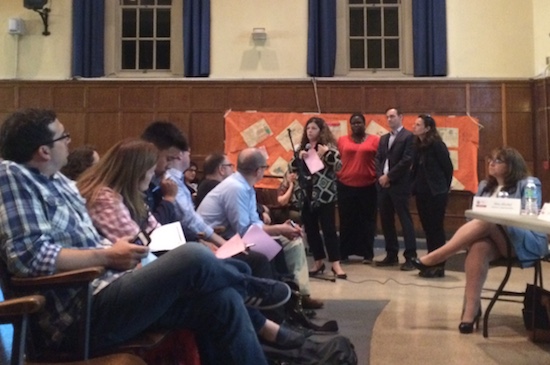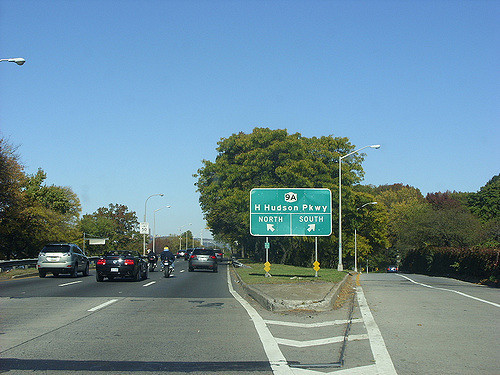
Parents listen to local principals at a school rezoning hearing last year.
By Jessica Brockington
Two lines of zoning discussion are happening simultaneously right now in District 3, according to Kimberly Watkins, chair of the Zoning Committee.
One involves the recent surprise announcement by the Department of Education that they will not be rezoning District 3 elementary schools for the 2017 school year. They’ve decided to wait until a new elementary school, Riverside Center PS 342, opens on 61st street and West End Avenue in 2018.
The DOE is basing that decision on a shorter waitlist at PS 199 on West 70th street, says Ilene Altschul, Superintendent of District 3. This year the waitlist is only 30 students, down from over 100 last year.
According to Watkins, parents are concerned that the school has a shorter waitlist because more children are being squeezed into the building: the school has 6 kindergarten classes in space designed for 5.
Dan Katz is leading a subcommittee looking at data for the Zoning Committee. He’s working to understand the utilization and capacity rates. PS 199 has been above 110% capacity for a protracted period, Watkins said.
The second line of discussion involves sweeping reform of neighborhood zone lines in an effort to address what critics are calling the intense segregation of elementary schools in the District. Through community forums over the past month, the District has explored a new way to decide where students are placed in elementary schools. It’s called “controlled-choice.”
Controlled-choice would allow parents and PTA’s to generate a list of priorities for their child’s school, weight those priorities, and then use a computer generated algorithm that would include mixing children of different socio-economic backgrounds.
Controlled-choice received negative feedback and some clashing opinions, however, when discussions were brought to the larger CEC3 meeting on March 31. Much revolved around what members felt were incomplete answers by the owner of the private company that developed and administers controlled-choice, Michael Alves.
“I’m a little troubled by how we’re not able to answer, at least in my mind, basic questions, operation questions about how this would work,” said Joseph Fiordaliso, President of CEC3, referring to an email list of questions directed at Alves.
“How are you going to force a kid to go to a school they don’t want to go to? How do I explain to a kid on 61st Street that they can’t go to the school across the street?” he asked.
The same way you explain that a child has to go to school that is completely underfunded, countered Noah Gotbaum, another CEC3 member.
“The threshold for eradicating neighborhood schools for me is significantly high,” Fiordaliso continued. The advocates for controlled-choice have been bringing the idea to CEC3 meetings for several years, he said, and still there are no details as to how it would work.
“If the rubber’s hitting the road here,” he said, “let’s talk operations. I want details, specifics, and how, operationally, this would work.”
Update: Ujju Agarwal, who sits on the steering committee of the District 3 Equity in Education Task Force, emailed a statement defending the controlled choice process: “It’s great that there are new questions and interest in district wide controlled choice that grow out of the recent community forums— demonstrating the real interest and need for a comprehensive and equity based admission policy that will address the crisis of segregation in our schools. Michael Alves did in fact, respond to the questions — I know because I was on the emails — but many of them are subjective and require more community discussion and dialogue. If there are questions that remain, the answer is not to close the door on controlled choice but rather, to engage these questions with the broader community. It’s an opportunity, not an ending.”
Nan Mead, chair of CEC3’s Diversity Committee, worried that controlled-choice is potentially years away from having any real effect. “There are things we can do right now with the same amount of money, like putting books in a library, rather than chasing down a prolonged process to explore this option,” she said.
Watkins pointed out that the goal of the Zoning Committee was to investigate and be able to understand what controlled-choice offers.
“No one is saying that a vote needs to take place or a letter needs to be written,” she told her colleagues at the full CEC3 meeting.
Dan Katz emphasized that the zoning system needs to be examined.
“Even if it [the system] is not creating the problems, it’s nurturing them. School catchments are generating high levels of need, inequitable funding,” he said. “At the same time we consider those needs, its important that we know if there are systemic issues that can be addressed.”
Read more about controlled choice here.









The question is about priorities. Once they are established, it will be relatively easy to determine an approach that achieves the main priority while not having too many negative effects (but not avoiding all negatives) on other elements. Desegregation should be the priority in my view. It is a stain on NYC/UWS. change may require some minor sacrifice by some but it always does.
Totally agree, Upper West Parent. It’s disgraceful that DOE is not moving to get our public schools fully desegregated. This is embarrassing. It’s not 1968 anymore.
Leave now parents. It’s only going to get worse for middle and high school. The DOE is just never going to get it’s act together in District 3 and otherwise and why put your children through this torture needlessly. Let them be kids and have a normal educational experience without having to jump through hoops and feel horrible about themselves because they didn’t get into a coveted or desired school? Let’s save that torture for college.
I am happy to see that the DOE is waiting for the new school to open so they don’t make changes year after year. I do, however, think that they could be setting out a plan today (like right now) for 2018 based on that new school opening, since they know it is going to happen. There is far too much drama here in the constant on again, off again, zoning solutions. And I believe that our children (and their parents) should not have to be anxious about getting into elementary school. Tell us the plan now. And if there isn’t a plan – shame on the DOE for not thinking ahead and shame on CEC3 for not forcing the DOE to present something now, instead of last minute, as is usually the case with the DOE. By the way, it has also come to my attention that even though there are meetings going on, preschool parents are not being reached by the district. Their preschools know nothing about what has been going on. Information should be sent to all preschools in the community – public and private.
Funny thing about the segregation issues in the UWS. Who drew the original lines that set up the districts all over the city? It wasn’t UWS parents trying to avoid integration. So we shouldn’t blame parents who moved into a zoned school area and are questioning why their zone should suddenly be at risk. It was the DOE, not UWS parents who set up the segregrated zone lines within District 3. . They set up a district, knowing that they had zoned schools within a bigger area called a district, and also knowing that those zoned schools had different racial and socio-economic make-ups from the beginning. Districts are random divisions of neighborhoods done many years ago. and so although we can point to the problems of segregation, today, we need to realize that the district lines could have been 10 blocks differently on the north and south parts of the district, had the lines been drawn differently. Perhaps instead of blaming UWS parents for segregation, and holding their children for ransom as this annual debate is held, we should recognize that people have purchased homes based on school zones that offered a record a high test scores, school safety, and the ability to walk to school. These are neighborhood schools. And before someone argues that people who buy homes don’t buy a place in their neighborhood school, it should be noted that that is not true. Home purchases by people with children ALWAYS include serious consideration of schools – and one should not assume that the majority of UWS kids go to private school. This is clear – this is why the schools are crowded. Parents bought homes with the intention to send their children to good public schools. I agree there is too much drama here.
“Controlled-choice would allow parents and PTA’s to generate a list of priorities for their child’s school…” What if priority #1 is for the child to go to PS199, the school right next door to home? Is there an algorithm for that?
Controlled choice sounds good. It sounds like people really have a choice. But after reading this article and listening to a recording of the committee meeting of the CEC3 group working on controlled choice https://www.spreaker.com/user/8322048/cec3-zoning-committee-march-21-2016
there are a ton of questions. If the man responsible for coming up with controlled choice, the one who gets paid to speak about his pet project can’t give them proper answers, then shouldn’t the whole thing be questioned? It sounds good to those of us who are hearing a locally devised description, but maybe that’s not what controlled choice is. After all, if I choose, who controls my choice? Certainly not me – someone else controls if I get my 1st, 5th or 9th choice. I agree with nycityny that my simple priority is to have a neighborhood school – conveniently located to our home which we purchased knowing the school for which it was zoned.
I see in the update that the question of controlled choice is still in need of clarification. In fairness, based on how long it took to implement in Cambridge and how long it is taking the LES to work out a plan, it seems that even 2018 is pushing it. Because of school application dates, information has to reach parents by November of the year before their kids enter school. And even that gives them very little time to study their options and make thoughtful choices. Perhaps is would be smarter for CEC3 to set a goal year such as 2019 and work toward a firm, and lasting decision. Seems more practical than the current year by year, on again off again, decision-making process that gets people worked up for no purpose. Let’s do this thing right.
they need to do it for 2018 because that’s when the new elementary school opens. If we don’t have controlled choice by then they need to rezone the lower part of the district for this new school. That alone will cause fights about who goes to the new school, who goes to underperforming 191 and who goes to well regarded 199. Add to that that once a child is in a school they get to stay until they age out and their siblings get priority to start k. So the first K class to enter the new PS 342 impacts what the student body will be like for quite a few years.
We won!
Those of us in the lower part of the district (as well as CEC leadership and elected) are having a small get together next week to celebrate the thwarting of the Controlled Choice initiative.
Congrats to everyone who has contributed to the debate by staying on message with the “how is this going to work, we don’t understand, my kids not going to go 60 blocks to school la la la, lets wait” commentary. Bravo on keeping a straight face while pretending a) not to understand the system and b) not mentioning race or real estate at all.
With any luck we’ve kicked this can far enough down the road so we don’t have to let those poors into our schools.
Oh – and even better – we get to point the finger at the DOE and make it like it wasnt even anything to do with us!
Canapes and champagne for everyone!
(well – not for everyone of course – in the 70s and 80s only)
Since everyone seems to have an opinion about what controlled choice means, does anyone ACTUALLY know what it means?
I am asking seriously, not being sarcastic. Does it mean a parent sets priorities on a check-off list but does not actually list the schools by name, so that a computer determines which school provides what the parent wants? That is very different from picking an actual list of prioritized schools. I am reading between the lines on school choice and in some articles I have found, parents don’t even get to say what schools they are comfortable traveling to. They list priorities such as distance, playground, before school care and then a computer determines the schools that meet that criteria, while weighting for socio-economic balance (systems no longer weight race. If parents can pick three schools and be guaranteed one of them, that’s one thing, but if a computer starts selecting from 14 schools that might meet some of your criteria, or if you are forced to rank all 14 schools, it will be a mess. And the first year is likely to be very confused, with a lot of unhappy people.
We really need to know a lot more. Also, does anyone ACTUALLY know if controlled choice affects EVERY child in the district or does it begin with kindergartners and work its way up? In other words, does everyone have to reapply? I think we are all making assumptions based on what we think we know – but what are the actual facts?
And lastly, if controlled choice is such a good idea, then we should be able to find a long list of places successfully implementing this. After all, it was started in Cambridge in about 1980, by Michael Alves, who is the creator of the plan. Although they still use it in Cambridge (the home of Harvard University) how many other places have implemented it in the past 35 years, and how many have kept it long term? Again, we need to have facts.
It is easy to say we want to end segregation in District 3, realizing that this does fix the NYC segregation issues, because people live in neighborhoods and often choose to live where their friends and family live, so it is likely that we will always see pockets of people gathering by ethnic background to live together in a community of their choosing. The segregation issue goes beyond public housing communities, it includes the fact that people of all socio-economic backgrounds may choose to live where they feel they are most comfortable due to language, ethnicity or religious beliefs. I am not sure that we can ever totally solve this problem. I for one, am willing to work on it, but again, I want facts.
Here’s a radical idea – screw “controlled choice” and just go all out for choice. Why do our choices have to be “controlled” anyway? We don’t have “controlled” choices as to where we bank, buy our groceries, eat in restaurants…. So why should we be locked into arbitrary boundaries over where we have to go to school? How about opening up all UWS/District 3 schools to an open lottery, and truly injecting some real choice and competition? Now that would be a radical, and egalitarian approach to our schools.